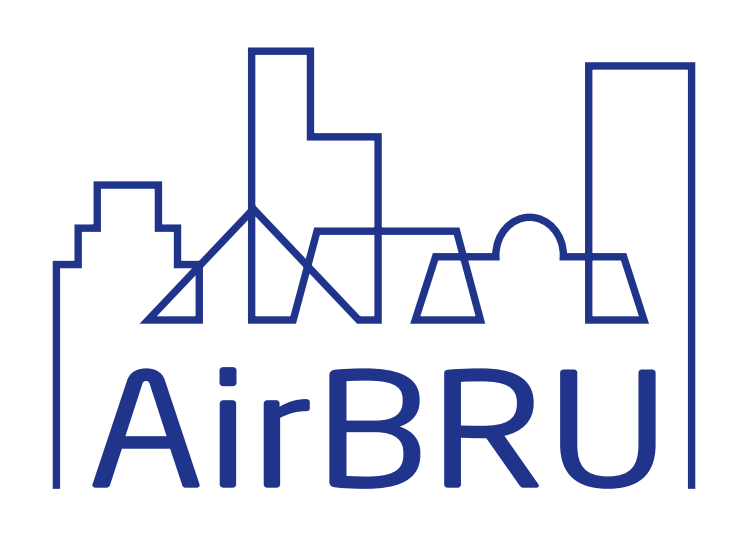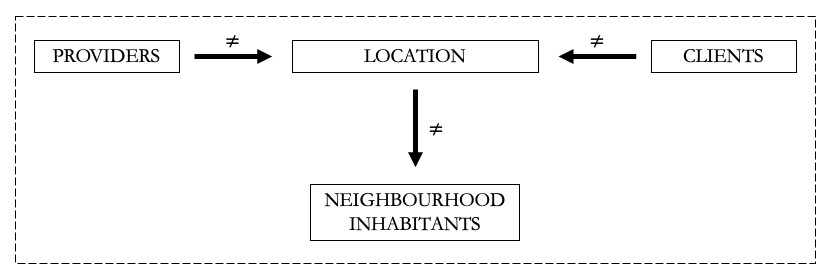
During the past decade, the offer in shared short-term rentals grew spectacularly in many tourist destinations. The Brussels-Capital Region is no exception: short-term rentals, advertised on ‘peer-to-peer’ platforms such as Airbnb and HomeAway, have become increasingly common in the city, targeted both at tourists and expats. Although the shared short-term rental market offers many opportunities, there are also many unknowns and potential risks related to this collaborative economy. The AirBRU project will add to our understanding of the challenges and consequences of the rise in short-term rentals in Brussels. It will examine the potential inequalities that come along with shared short-term rentals in the Brussels-Capital Region focussing on:
1. The spatial patterning of shared short-term rentals;
2. The type of providers of shared short-term rentals;
3. The supply, the characteristics and the accessibility of short-term rentals, as well as the contact between users and providers;
4. The consequences for the local residents
5. Finally, the project intends to formulate evidence-based policy recommendations to tackle the problems of socioeconomic, demographic and residential inequalities in relation to shared short-term rentals
Shared short-term rentals and the Covid-19 pandemic
The COVID-19 pandemic has had a substantial impact on shared short-term rentals worldwide. In Belgium, tourism was abruptly halted during the lockdowns (March through May 2020 and November 2000 through January 2021), due to travel restrictions and the closure of hotels, bars and restaurants. In addition, work-related travel drastically slowed down as working from home became the norm. In the AirBRU project we will be able to investigate exactly how the short-term rental market was affected by the pandemic and how it will recover in the coming years. Moreover, we will pay special attention to whether the pandemic gave rise to new inequalities in the housing market and in the tourism and hospitality sector in Brussels.
Below is a selection of recommended reads on the impact of the Covid-19 pandemics on shared short-term rentals around the world.
More information on the demographic aspects of the pandemics can be found on the COVID page by Interface Demography.
Press articles:
EN
- The Results Are In for the Sharing Economy. They Are Ugly. The New York Times, 7 May 2020
- Hotels vs. Airbnb: Has Covid-19 Disrupted the Disrupter? The New York Times, 14 May 2020
- The Future of Airbnb. The New York Time, 24 September 2020
FR
- Avec le coronavirus, le modèle Airbnb “prend une claque”. RTBF, 11 May 2020
- L'”économie du partage” bouleversée par la pandémie. Trends-Tendances, 13 May 2020
- Le syndrome Airbnb ou l’économie du partage au défi du coronavirus. Les Echos, 20 June 2020
NL
- Zwaarste test ooit voor deeleconomie. De Tijd, 14 April 2020
- Jubeljaar wordt ramp voor Airbnb. De Standaard, 20 April 2020
- Airbnb schrapt kwart van alle jobs en ziet omzet halveren. Trends, 6 May 2020
Scientific works:
- Nhamo, Godwell, Dube, Kaitano, & Chikodzi, David (2020). Impacts and Implications of COVID-19 on the Global Hotel Industry and Airbnb. In Nhamo, Godwell, Dube, Kaitano David Chikodzi, Counting the Cost of COVID-19 on the Global Tourism Industry. Springer.
- Farmaki, Anna, Miguel, Cristina, Drotarova, Maria Hadjielia, Aleksić, Ana, Čeh Časni, Anita, & Efthymiadou, Fani (2020). Impacts of Covid-19 on peer-to-peer accommodation platforms: Host perceptions and responses. International Journal of Hospitality Management, 91.
- Dolnicar, Sara, & Zare, Samira (2020). COVID19 and Airbnb – Disrupting the Disruptor. Annals of Tourism Research, 83.

Introduction
During the past decade, ‘shared’ or ‘collaborative’ short-term property rentals grew spectacularly in many tourist destinations. Likewise, the Brussels-Capital Region (BCR) experienced a rapid increase of available shared short-term rentals, advertised on digital rental platforms such as Airbnb and HomeAway. The collaborative short-term rental housing market entails many economic opportunities but has been increasingly criticised in popular cities such as London, Amsterdam, Barcelona and Paris [1], [2]. There are many concerns and unknowns about the appearances, the disruptive effects and new inequalities associated with shared short-term rentals.
The BCR is no exception in this respect[3]. Therefore, the first challenge is to get a better insight into the size, the geographic spread and the composition of short-term rentals. International projects – such as ‘AirDNA’ and ‘InsideAirbnb’ – estimate that there are respectively 5,422 and 7,420 registered Airbnb listings in the BCR of which respectively ca. 54% and 39% are put up for rent by multi-listing providers. The regional administration suggests a total of 6,715 registered accommodations of which 35% is let by multi-listing providers. Important uncertainties not only relate to inaccurate counts, but also to the (unequal) distribution of listings across the Brussels territory, the unknown characteristics of the providers and the services/provisions offered to clients as well as the consequences for the local housing market and residents.
The figure below provides an overview of the building stones of the AirBRU-project. Four dimensions are distinguished: (1) the location of shared short-term rentals; (2) the providers of these rentals; (3) the clients of these rentals; and (4) the consequences of shared short-term rentals for the local inhabitants. The AirBRU-project considers each of these dimensions in separate research objectives, all the while focusing on the interrelations between the various dimensions. In a final stage and based on the research results, (5) the project will deliver evidence-based policy recommendations.

Overview of the AirBRU-project

[1] Llop, N.L. (2017). A policy approach to the impact of tourist dwellings in condominiums and neighbourhoods in Barcelona. Urban Research and Practice, 10, 120-129.
[2] Yoonjoung Heo, C., Blal, I., Choi, M. (2019). What is happening in Paris? Airbnb, hotels, and the Parisian market: A case study. Tourism Management, 70, 78-88.
[3] European Commission (2018) Study on the assessment of the regulatory aspects affecting the collaborative economy in the tourism accommodation sector in the 28-member states – Task 4 Market case study – Brussels. European Commission – Directorate General Internal Market, Industry, Entrepreneurship and SMEs (DG GROW), p.29.
Research objectives
Objective 1: Location of shared short-term rentals
The first objective is to study the residential patterns of the shared short-term rentals in the BCR at various spatial levels. Not only the patterns as such are analysed, but also their association with the availability of traditional hospitality services and the socioeconomic and socio-demographic composition of the area.
Aims:
- Establish a clear picture of the residential over- and under-concentration of the shared short-term rentals in BCR’s neighbourhoods;
- Examine to which extent there is a distance-decay effect (i.e. the greater the distance from existing tourist hot spots, the lower the likelihood that people will offer their property for rent on shared short-rental platforms) and potential spill-over effect of tourist hot spots;
- Analyse to what extent the residential patterning of collaborative short-term rentals is related to socioeconomic and demographic characteristics of neighbourhoods.
Objective 2: Characteristics of shared short-term rental providers
The second objective zooms in on the supply side by looking into the characteristics of shared short-term rental providers in the BCR.
Aims:
- Investigate the extent to which shared short-term rentals in BCR are offered by professional versus non-professional providers;
- Acquire a more complete picture of the supply side by analysing other shared short-rental platforms than Airbnb;
- Connect the first and second objective by examining whether particular provider-profiles are disproportionally located in particular urban locations.
Objective 3: Unequal access to short-term rentals for potential clients
The third objective focusses on the demand side and investigates the clients who potentially use shared short-term rentals. Initially, the collaborative economy was meant to improve access to services and goods by directly connecting peers to peers. Nonetheless, the access to short-term rentals could be in fact very unequal. This inequality involves at least two aspects: discrimination of potential guests and inadequacy of the current supply of shared short-term rentals in the BCR for specific profiles of guests.
Aims:
- Examine digital discrimination on the shared short-term rentals platforms based on ethnic origin, sexual orientation, gender and physical disability;
- Investigate the supply of available shared short-term rentals for specific categories of potential clients;
- Analyse the interrelations between the research objectives 1 through 3.
Objective 4: Consequences of shared short-term rentals for local neighbourhood inhabitants
The fourth research objective concentrates on the consequences of shared short-term rentals for the local neighbourhood residents. More specifically, two potential negative aspects of shared short-term rentals are analysed more closely: their effect on the long-term rental market (shrinkage of housing supply and increase of rental prices) and on the local residents (potential displacement to other neighbourhoods).
Aims:
- Evaluate whether shared short-term rentals affect the supply and the rental prices of dwellings in the long-term rental housing market in the BCR;
- Analyse how the concentration of short-term rentals in certain neighbourhoods may be linked to actual displacement of local residents.
Objective 5: Formulating evidence-based policy solutions
The fifth objective of the AirBRU-project is to formulate evidence-based policy recommendations to tackle inequalities and to mitigate negative effects of the shared short-term rental market in the BCR. By analysing several aspects related to shared-short term rentals, we will be able to formulate policy measures to tackle the challenges related to each objective:
- The location of the shared short-term rentals;
- The supply side (providers);
- The demand side (clients);
- The potential consequences of shared short-term rentals for the conventional long-term rental market as well as the residents of neighbourhoods.

Data and Methodology
The project makes use of advanced quantitative analyses using an innovative combination of different data sources, namely:
- Detailed data on shared short-term rentals in Brussels, including their location, characteristics, occupation and price on a daily basis;
- Big data on the long-term rental market and on hospitality services obtained through web scraping;
- Information on digital discrimination obtained through correspondence tests;
- Individual-level data from the Census and population registers;
- Fine-grained spatial indicators based on individualised neighbourhoods constructed around geographic coordinate points.

Output
Dissemination
Download the presentation about the AirBRU project.
Who are we?
Promotors
Researchers

Partner Institutions








